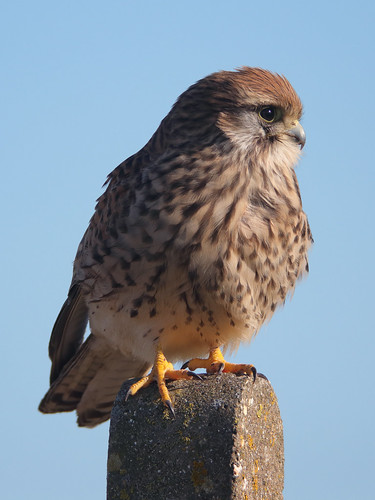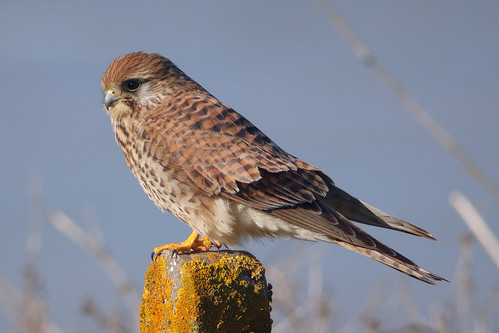I don't usually bother with top-ten lists or stuff like that, but if I had to choose a favourite bird it would undoubtedly be the Kestrel. It's not the biggest (or smallest) bird of prey; nor is it the most colourful. It's not even the only British bird that hovers, though the other contenders can't hope to match its precision or its tenacity. But, more than any other bird, it's always been a small part of my life in some shape or form. It was there on the striking red badge I received when I joined the YOC:
It was there in Ken Loach's famous film (adapted from the novel by Barry Hines) that I saw in my early teens. And it was there at the start and end of the summer holidays, glimpsed from the side window of a car; a bird that seemed to defy not just gravity but time itself as it hovered above the roadside verges while the twentieth century flowed around it.
I've had the privilege of seeing a wild kestrel up close on a couple of occasions, most recently in February of this year when I encountered one perched in a small tree by the North Foreland golf course. I took some photos and continued on to Botany Bay to see if there was anything interesting on the shore. When I turned around to walk back I was surprised to see the same kestrel standing on a fence post. Naturally, I couldn't pass up the opportunity to take some more photos:
From badges to films to poetry (see: The Windhover by Gerard Manley Hopkins) there is something about the kestrel that seems ingrained in the British psyche. A good example of this can be found in Powell and Pressburger's 1944 wartime classic A Canterbury Tale. In the film's prologue, a group of medieval pilgrims make their way towards Canterbury while a voiceover narrates a passage from Chaucer's text. A falconer stops to release a kestrel into the sky. The bird dips and soars ... and transforms into a Spitfire flying above the English countryside. Four hundred years of history spanned in a single cut.

Effortlessly at height hangs his still eye.
His wings hold all creation in a weightless quiet,
Steady as a hallucination in the streaming air.
Ted Hughes, The Hawk in the Rain (1957)
See also:
More of my Kestrel photos on Flickr
Kestrel (RSPB)
Kestrel (Birdforum)
Kestrel (Birdguides)





Nice post, terrific photos and a 2001 link - bonus!
ReplyDeleteThanks Martin.
Delete